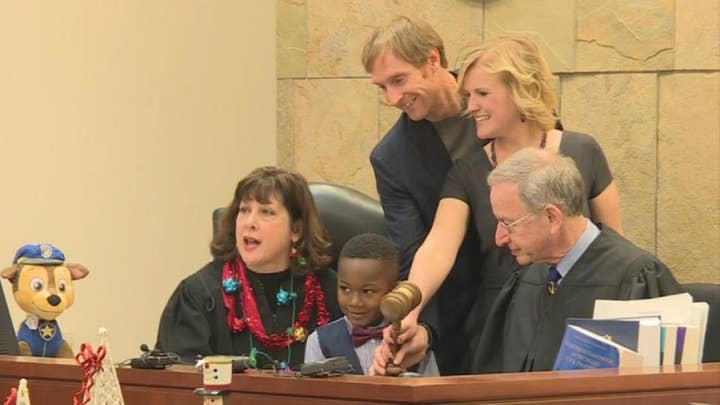COVID-19 travel restrictions freeze adoptions
Ivy and Noah Cleveland, couple attempting to adopt from China, share their story on 'America's Newsroom.'
Every child has the inherent right to be a part of a loving, caring and secure family. It’s a truth that we have championed for more years than we can count, yet it is juxtaposed with the reality that some 15 million children around the world are living outside the love, security and permanency of a family.
Our most recent federal reports show that approximately 400,000 children are being cared for in the U.S. foster care system with 120,000 of them having had parental rights terminated. And those numbers are only climbing.
According to a joint report released this summer by the Centers for Disease Control (CDC), our understanding of the COVID-19 impact across the globe has only begun – "with more than 1.5 million children experiencing the death of a parent or grandparent caregiver who lived in their homes and helped care for them."
HUMAN RIGHTS BEGIN IN THE WOMB
The landscape of adoption, too, has dramatically changed over the past 20 years with the total number of intercountry adoptions declining by 87%. And while adoptions continue to be on the decline – only further complicated by the COVID-19 pandemic—the cost associated with adoption continues to rise. Today, we estimate the cost of domestic and intercountry adoptions to range between $25,000 and $50,000. That is simply outside the reach for most families.
Also staggering is the number of children who have been orphaned with mild to acute health care needs, requiring access to medical or therapeutic intervention. According to a leading adoption agency, 68% of the intercountry adoptions they processed in 2019 involved children with special needs.
Certainly, the needs of children impacted by adoption and/or foster care are, in many cases, complex and unique. These children have often experienced early attachment injuries related to loss, abuse, trauma and/or neglect. And traditional parenting methods and models can fall short in providing the love, care and healing vulnerable children so desperately need.
There are resources available to reduce the financial barriers as well as answers, insight and guidance both pre- and post-adoption.
These are some of the primary barriers standing between waiting children and families – financial, medical and knowledge barriers. And yes, these barriers can easily be perceived as insurmountable. But there is hope and help, and well, something must be done.
Our family began the adoption journey some 20 years ago – first, with our daughter Shaohannah Hope, then with Stevey Joy, and finally with Maria, who is now with Jesus – and since 2003, as founders, we have devoted ourselves to guiding the nonprofit Show Hope with its mission to care for orphans by engaging the church and reducing barriers to adoptions. Instead of running from adoption because it seems too challenging or complex, we should all be encouraged.
WHEN YOU PRAY THIS HOLIDAY SEASON WORRY LESS AND THANK JESUS MORE
Whether you are considering adoption, knee-deep in the process itself or are simply wanting to learn more, there are resources available to reduce the financial barriers as well as answers, insight and guidance both pre- and post-adoption. These gifts – as we call them – were not as accessible or available when we were in the midst of adoption, and as we have grown and learned more, we have been committed to walking alongside children and families on these journeys of hope and healing.
Today, there are organizations, nonprofits, and ministries – like Show Hope – that offer financial aid grants to help offset the cost associated with adoption, and some of these same entities are even offering funding for post-adoption needs, including medical and behavioral health. State and federal tax credits are also available for adoptive families as well as no- or low-interest loans. Available today are sliding scale fees based on a family’s income or ability to pay, and subsidies are offered for adoptions through foster care. Employers are also stepping up and offering adoption fee benefits for employees as well as maternity and paternity leave comparable to parents welcoming children biologically.
Our understanding of the needs of children who have been orphaned has also deepened over the past several years. Research related to early childhood trauma and its impact on attachment continues to grow, and from that, a number of helpful, practical resources and organizations are now available to come alongside parents and families with informed support and care.
Show Hope’s own Pre+Post Adoption Support programmatic work was founded out of a desire to journey well and intentionally with children and families, post-adoption. The Karyn Purvis Institute of Child Development at TCU is a leading voice in science and research related to children impacted by foster care and adoption and how to better serve and meet their complex needs.
CLICK HERE TO GET THE OPINION NEWSLETTER
Developed Drs. Karyn Purvis and David Cross, the institute’s care model has become a leading standard in the adoption and foster care communities and offers a holistic approach to caring well for children – a model that is not only embraced by parents and caregivers but one embraced by professional here in the U.S. and around the globe. Resources like "The Connected Child," "The Connected Parent" and "The Whole-Brained Child" continue to help parents, caregivers, professionals and communities reduce that knowledge barrier.
As Mary Beth has said countless times, "Not everyone is called to adopt, but everyone is called to do something." And we stand by that truth today. Apart, we can do so little, but together, we do so much.



